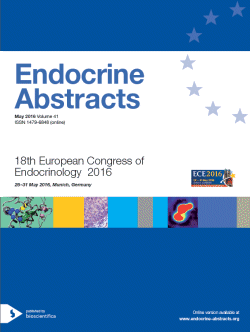Guided Posters
Neuroendocrinology
ea0041gp119 | Neuroendocrinology | ECE2016
Hypoxia-inducible factor 1α triggers growth hormone synthesis in acromegalic tumors
Lucia Kristin , Monteserin-Garcia Jose , Buchfelder Michael , Renner Ulrich , Stalla Gunter , Theodoropoulou Marily
ea0041gp120 | Neuroendocrinology | ECE2016
High-resolution spatiotemporal analysis of Somatostatin Receptor Type 2 (SSTR2) – Filamin A (FLNA) interaction by single-molecule imaging
Treppiedi Donatella , Mantovani Giovanna , Peverelli Erika , Sungkaworn Titiwat , Zabel Ulrike , Giardino Elena , Lohse Martin J , Spada Anna , Calebiro Davide
ea0041gp121 | Neuroendocrinology | ECE2016
Expression of dopamine (DA) D2 receptors (D2R) in corticotroph cells is responsible for the switch of hypothalamic regulation of ACTH secretion to DA in lactating rats
Nagy Gyorgy M. , Feher Palma , Bodnar Ibolya , Reid Luke , Toth Zsuzsanna E. , Vecsernyes Miklos , Toth Bela E.
ea0041gp122 | Neuroendocrinology | ECE2016
Lipid content and ATP metabolism in the liver of patients with acromegaly
Winhofer Yvonne , Wolf Peter , Smajis Sabina , Krssak Martin , Gajdosik Martin , Micko Alexander , Wolfsberger Stefan , Knosp Engelbert , Vila Greisa , Raber Wolfgang , Trattnig Siegfried , Luger Anton , Krebs Michael
ea0041gp123 | Neuroendocrinology | ECE2016
A placebo-controlled study to assess the dose-effect of COR-005, a novel somatostatin analogue on plasma glucose regulation compared to octreotide in healthy male subjects
Kutz Klaus , Haschke Manuel , Beglinger Christoph , Dehning Carsten , Cohen Fredric
ea0041gp124 | Neuroendocrinology | ECE2016
Endothelial damage and thrombotic response in patients with cured Cushing syndrome
Aranda Velazquez Gloria , Mora Porta Mireia , Halperin Irene , Fernandez Rebeca , Diaz-Ricart Maribel , Palomo Marta , Vidal Oscar , Ensenat Joaquim , Casals Gregori , Alexandra Hanzu Felicia
ea0041gp125 | Neuroendocrinology | ECE2016
Cabergoline therapy in clinically nonfunctioning pitutiary adenoma: results of a clinical trial
Loch Batista Rafael , Cunha-Neto Malebranche , Musolino Nina , Borba Clarissa , Cescato Valter , Silva Gilberto , Trarbach Ericka
ea0041gp126 | Neuroendocrinology | ECE2016
Abnormal hypothalamus and related brain regions in Prader–Willi syndrome evaluated in vivo by diffusion tensor imaging (DTI)
Caixas Assumpta , Fenoll Raquel , Pujol Jesus , Bueno Marta , Esteba Susanna , Blanco-Hinojo Laura , Macia Didac , Novell Ramon , Coronas Ramon , Gimenez-Palop Olga , Rigla Mercedes , Deus Joan
ea0041gp127 | Neuroendocrinology | ECE2016
Hypothalamic GRK2, via GPR54, modulates puberty onset
Avendano Ma Soledad , Ruiz-Pino Francisco , Vazquez Ma Jesus , Velasco Inmaculada , Heras Violeta , Torres Encarni , Manuel Castellano Juan , Roa Juan , Pinilla Leonor , Tena-Sempere Manuel
ea0041gp128 | Neuroendocrinology | ECE2016
Latest results from the PATRO adults study of Omnitrope® for the treatment of adult patients with growth hormone deficiency
Beck-Peccoz Paolo , Hoybye Charlotte , Murray Robert , Simsek Suat , Leal-Cerro Alfonso , Zabransky Markus , Stalla Gunter




